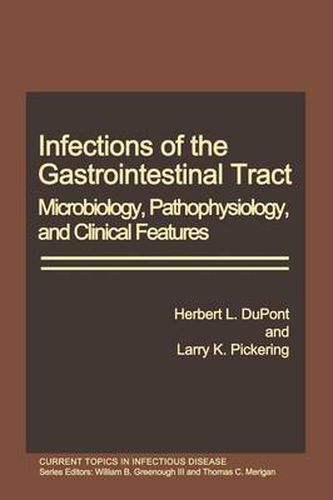Readings Newsletter
Become a Readings Member to make your shopping experience even easier.
Sign in or sign up for free!
You’re not far away from qualifying for FREE standard shipping within Australia
You’ve qualified for FREE standard shipping within Australia
The cart is loading…






This title is printed to order. This book may have been self-published. If so, we cannot guarantee the quality of the content. In the main most books will have gone through the editing process however some may not. We therefore suggest that you be aware of this before ordering this book. If in doubt check either the author or publisher’s details as we are unable to accept any returns unless they are faulty. Please contact us if you have any questions.
Enteric infection has played an important role in the majority of the world’s populations, including children (particularly those under four years of age), the aged, the malnourished, military populations, and per sons from industrialized regions traveling to developing areas. The magni tude of the problem has been profound in areas of the world with reduced economic development, where there exists a greater reservoir of entero pathogens and a larger susceptible population with nutritional deficits. Morbidity from enteric infection in developing areas exceeds that seen in industrialized countries by severalfold, with the problem being most seri ous in infants who are bottle-fed and other infants and young children soon after being weaned from the breast ( weanling diarrhea ). Of greater significance than the inverse relationship of diarrhea morbidity with levels of industrial development is the relationship of death from intestinal infection and socioeconomic advancement. Mortality rate from diarrhea is 10 to 100 times greater in developing areas. In many parts of the third world, diarrhea, resultant dehydration, and associated malnutri tion are the leading causes of death in infants and young children and account for as great as one-third of pediatric deaths.
$9.00 standard shipping within Australia
FREE standard shipping within Australia for orders over $100.00
Express & International shipping calculated at checkout
Stock availability can be subject to change without notice. We recommend calling the shop or contacting our online team to check availability of low stock items. Please see our Shopping Online page for more details.
This title is printed to order. This book may have been self-published. If so, we cannot guarantee the quality of the content. In the main most books will have gone through the editing process however some may not. We therefore suggest that you be aware of this before ordering this book. If in doubt check either the author or publisher’s details as we are unable to accept any returns unless they are faulty. Please contact us if you have any questions.
Enteric infection has played an important role in the majority of the world’s populations, including children (particularly those under four years of age), the aged, the malnourished, military populations, and per sons from industrialized regions traveling to developing areas. The magni tude of the problem has been profound in areas of the world with reduced economic development, where there exists a greater reservoir of entero pathogens and a larger susceptible population with nutritional deficits. Morbidity from enteric infection in developing areas exceeds that seen in industrialized countries by severalfold, with the problem being most seri ous in infants who are bottle-fed and other infants and young children soon after being weaned from the breast ( weanling diarrhea ). Of greater significance than the inverse relationship of diarrhea morbidity with levels of industrial development is the relationship of death from intestinal infection and socioeconomic advancement. Mortality rate from diarrhea is 10 to 100 times greater in developing areas. In many parts of the third world, diarrhea, resultant dehydration, and associated malnutri tion are the leading causes of death in infants and young children and account for as great as one-third of pediatric deaths.